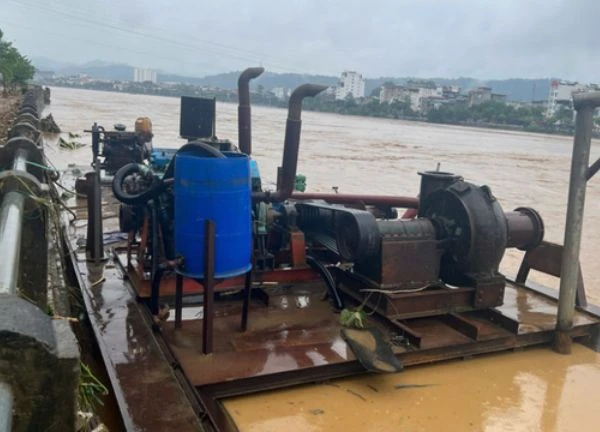Heartbroken young man in Thanh Hoa was swept away by flood water and died before his wedding day

4 | 1 Discuss | Share
On September 6, when super typhoon Yagi was maintaining its destructive power in the Gulf of Tonkin with winds of level 15, gusts of level 17, the entire North experienced a record hot day.
The mountainous town of Ha Giang on the afternoon of September 6 recorded a temperature of 39.5 degrees - the highest temperature in the history of September in this area, surpassing the record set 23 years ago. In Lao Cai, the heat was even more intense when the temperature reached 39.7 degrees, also the highest temperature in September in this land and the highest September temperature in the history of the North. Lao Cai, Tuyen Quang, Thai Nguyen, Bac Giang, Bac Kan, Vinh Phuc all recorded temperatures above 38 degrees, surpassing the records set in previous years. The capital Hanoi recorded a temperature of 37.5 degrees on September 5 and 37.3 degrees on September 6, also September temperature records here.
According to the National Center for Hydro-Meteorological Forecasting, 18 northern provinces and cities recorded record September temperatures on September 5-6. According to experts, the very high temperatures, combined with the western edge of Typhoon Yagi, caused strong thunderstorms ahead of the storm, leading to strong gusts of wind and heavy rain on the afternoon of September 6 in Hanoi and many other localities, even though the storm had not yet entered, causing a lot of material damage, including casualties before the storm.
On September 7, Yagi made landfall in Hai Phong - Quang Ninh, then swept across the Northern Delta with unprecedented intensity, with a very large area of influence. On September 8-9, the storm's circulation caused heavy rains throughout the North. The famous tourist town of Sa Pa recorded rainfall on September 8 of more than 300mm, far exceeding the record set 54 years ago. Many other measuring points in Lao Cai also recorded record rainfall such as Bac Ha and Pho Rang.
This province suffered the heaviest human and property losses when many flash floods and landslides occurred due to prolonged heavy rains and rising floods. Yen Bai was the province that suffered the heaviest rainfall. Rainfall in Luc Yen on September 9 was 316mm, breaking the record from 2012, and in Yen Bai city on September 10 it was 264.5mm. The total rainfall in 2-3 days in Yen Bai was particularly large, with many places reaching 500-600mm.
According to data from the National Center for Hydro-Meteorological Forecasting, 12 provinces and cities (out of 25 provinces and cities) in the North recorded the highest rainfall in a day in September, including Lang Son, Hai Phong, Son La, Lao Cai, Thai Nguyen, Vinh Phuc, Quang Ninh, Dien Bien, Yen Bai, Ha Giang, Cao Bang, and Nam Dinh.
Due to prolonged heavy rain, the flood on Thao River in Yen Bai on September 10 rose to 35.73m, exceeding the historical flood peak that existed 53 years ago. Cau River in Dap Cau (Bac Ninh) also reached a record level from 1971. Hanoi also recorded the highest water level of the Red River in the past 20 years. Lo River, Thuong River, Gam River, Thai Binh River, Luc Nam River, and Hoang Long River all exceeded alert level 3.
Representatives of the National Center for Hydro-Meteorological Forecasting said that floods and inundation on a large scale in the Red and Thai Binh river basins - the largest river system in the North - with many places exceeding the threshold is rare. Statistics show that 20/25 provinces and cities in the North experienced severe flooding after Typhoon Yagi.
Yagi made landfall in our country on September 7 and became a historic storm due to its intensity and terrifying devastation. For the first time in history, a location on the mainland of our country recorded strong winds of level 14, gusting to level 17 (Quang Ninh), and for the first time, a non-coastal locality recorded strong winds of level 12, gusting to level 13 (Hai Duong).
The National Center for Hydro-Meteorological Forecasting pointed out 4 unusual points of this historic storm. This is the strongest storm in the past 30 years in the East Sea, a storm that increases in intensity very quickly (increasing 8 levels in 48 hours), maintains super typhoon level for a long time and stays on land for a very long time (12 hours). Yagi also has an irregular development, does not weaken when passing Hainan Island, maintains very strong intensity in the Gulf of Tonkin and when making landfall.
According to experts, the worrying thing is that super typhoons may appear more and more in the East Sea. Throughout history since observation data was available, only 3 storms have strengthened into super typhoons in the East Sea: Yagi, Saola and Rain. Notably, all three of these storms appeared in the past 4 years (Rain in 2021, Saola in 2023), showing a trend of more and more super typhoons appearing in the East Sea.
In our country, in September, when the North had not yet overcome the catastrophic consequences of storm No. 3, the Central region suffered from storm No. 4. Although not as strong and having a short impact time, storm No. 4 also caused floods and inundation in some central provinces such as Quang Binh, Ha Tinh, and Nghe An. The National Center for Hydro-Meteorological Forecasting said that the peak of this year's storm season in the Central region may occur in October and November, not excluding the risk of storms overlapping storms and floods overlapping floods as happened in the historic storm season of 2020.
Yen Bai: Landslide at dawn made the family of a kindergarten teacher not survive  Quỳnh Quỳnh11:02:04 11/09/2024The landslide occurred at dawn in Minh Bao commune (Yen Bai city, Yen Bai province), causing the whole family of 4 kindergarten teachers not to survive, of which the youngest was only 2 months old.
Quỳnh Quỳnh11:02:04 11/09/2024The landslide occurred at dawn in Minh Bao commune (Yen Bai city, Yen Bai province), causing the whole family of 4 kindergarten teachers not to survive, of which the youngest was only 2 months old.

4 | 1 Discuss | Share

3 | 1 Discuss | Share

2 | 1 Discuss | Share

2 | 1 Discuss | Share

2 | 1 Discuss | Share

1 | 1 Discuss | Share

3 | 1 Discuss | Share

2 | 1 Discuss | Share

1 | 1 Discuss | Share

3 | 1 Discuss | Share

6 | 1 Discuss | Share

1 | 1 Discuss | Share










3 | 1 Discuss | Report